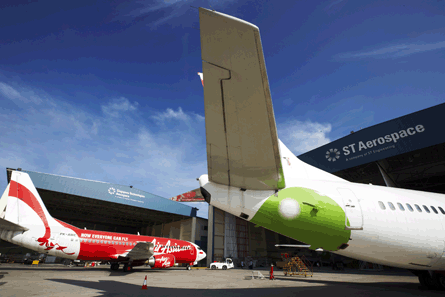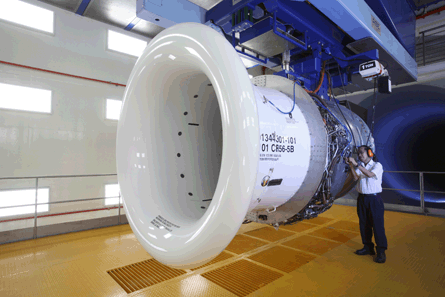The aviation industry might have taken one of its biggest hits during last year's global recession, but ST Aerospace chairman Tay Kok Khiang is an upbeat man.
The Singapore-based maintenance, repair and overhaul group has its eyes set on expansion abroad and at home, and ST Aero plans to make a foray into the business aviation sector in Singapore's Seletar Aerospace Park.
Even though the 35-year-old company has already established its presence in the Americas and Europe as well as Asia Pacific, ST Aero is still on the look-out for new markets.
 |
|---|
© ST Aerospace |
"We continue to look at growth options because we are very positive about the aviation market. Look at the last 20 years - whatever you throw at it, may it be a downturn or oil price crisis, the trend is that the industry continues to grow," says Tay.
While airlines all over the world cut costs and chalked up losses in the wake of the economic downturn, Tay remains sanguine about ST Aero's prospects, believing that the outlook for the business is good, thanks to the company's strong customer base.
ST Aero posted a net profit of S$57.8 million ($41.7 million) in the quarter ended 30 September 2009, down 6% from the same period in 2008, but 17% higher than the previous quarter. "We are profitable, and in real terms, significantly profitable compared with most other aviation MRO companies," says Tay.
The slashing of budgets by airlines benefited third-party MRO firms like ST Aero, he adds. New customers, such as Delta Air Lines, also came on board. "I wouldn't say it's a miracle, but it's quite encouraging," he says.
The business was also helped by low-cost carrier customers, such as South Korea's Jeju Air. "Most of the growth in the aviation industry is actually driven by the low-cost carriers," adds Tay.
GROWING ABROAD
Over the past five years, ST Aero has steadily grown its business in China, parts of Europe and Central America. In 2008, the company set up an engine MRO facility in Xiamen under a joint venture agreement with Xiamen Aviation Industry to offer CFM56-5B and CFM56-7B capabilities. The facility will start operations in the middle of this year, says Tay.
 |
|---|
© ST Aerospace"You can't cut costs too much, because you'll compromise your quality"Tay Kok KhiangST Aerospace chairman |
As well as Xiamen, ST Aero has already established businesses in Shanghai and Guangzhou. A two-hangar facility at Shanghai's Hongqiao airport was set up in 2004 under a joint venture agreement with China Eastern Airlines.
ST Aero plans to expand this further. It acquired a piece of land at Shanghai's Pudong International airport two years ago, and has started construction of a new hangar. It will be fully certificated by late February, says Tay. With space for two widebody and three narrowbody aircraft, the new hangar will double the capacity in Shanghai, he adds.
It will also be able to accommodate the Airbus A380, although Tay does not expect the superjumbo jet at the hangar too often. "The A380 numbers will be very small, because how many A380s will be bought? Maybe 100, or 120, and they are scattered all over the world," he says.
Over in Guangzhou, the company set up its first import and export facility in 2007 to carry out aircraft component distribution in the country.
Outside China, ST Aero also expanded its footprint in the Americas, when it established an airframe MRO facility in Panama, which started operations in May 2007.
In 2006, it acquired components MRO firm SAS Component in Copenhagen (later renamed ST Aerospace Solutions). Two years later, it set up a landing gear MRO joint venture with Iberia in Madrid.
Looking ahead, the firm plans to expand into more low-cost regions in the world. South America is a possibility. "We are now in Central America [Panama] so we are only one step away," says Tay.
India and China, with their educated workforces and growing aviation industries, also have potential, he adds. However, he acknowledges that the Indian market might be challenging, as the country has only 300 aircraft in operation. "It's a very splintered market and relatively small. Just to give an idea of scale, FedEx, a customer of ours, has 600 aircraft," he says.
As for China, Tay does not rule out having a bigger presence there, but he believes that the market is "much more limited than people think it is". Air China and China Southern Airlines already have their own MRO capabilities, he points out. However, the total aircraft fleet of the smaller airlines make up a "significant" market, says Tay.
ST Aero has been "fortunate" to win the business of smaller Chinese airlines including China United Airlines, Shanghai Airlines, Spring Airlines and United Eagle Airlines, says Tay. The firm will also continue to use China as a base to serve non-Chinese airlines, such as All Nippon Airways. "That's the main objective for us in China, it's not to go into China to do Chinese work," he says.
DOMESTIC EXPANSION
In February 2008, ST Aero opened its newest hangar in Singapore at the Seletar Aerospace Park. Including this two-bay hangar, the MRO firm has 25 widebody and 43 narrowbody bays in its hangars worldwide. Of these, 21 bays are in Singapore at three different locations: Changi, Paya Lebar and Seletar.
ST Aero will continue to invest in its home base, which it believes has a certain advantage over other countries, says Tay. For one, Singapore is a strong aviation hub with efficient customs authorities. "Anything from anywhere can be moved in very rapidly and that's important for aviation," he says.
"In Singapore, we have a good cluster of aviation activities," adds Tay, who says that it makes outsourcing easier. The island state has an educated workforce, with ST Aero employing 450 engineers in Singapore alone - the biggest group of engineers among its worldwide operations.
Intellectual property rights are also well protected in Singapore - an assurance to businesses engaged in collaborations, says Tay.
 |
|---|
© ST Aerospace |
ST Aero remains positive about its business at Seletar, where it introduced freighter conversion activities in late 2008. The business has been doing "very well", he says.
Going forward, plans to enter the business aviation sector at Seletar are on the cards, reveals Tay. There are firm plans to start something within three years, he says, adding that the group is considering introducing components and logistics work in Seletar. This is on top of its airframe maintenance, freighter conversion and pilot training capabilities there.
Operating in Singapore, however, will always have its challenges. Labour, land and infrastructure costs in the land-scarce island are higher than in most parts of the world, says Tay. "If you compare the land costs in Singapore with China, the USA, Europe - it's much higher," he adds.
But in the near future, Singapore can expect competition as China modernises. "The volume is there and the cost structure is advantageous," says Tay.
LOOKING AHEAD
ST Aero hopes to develop its engine development capabilities, in addition to maintaining its airframe maintenance and component and engine support businesses.
"We are probably one of two or three companies in the world to have an inherent engine development capability. We believe this area has good potential because it enables us to leverage our inherent capabilities for engine development into new products," says Tay.
Curbing costs, however, will remain a key challenge for the MRO business. "How do MROs provide the same level of service, or even better service, and at the same time lower the cost? That is the challenge for many people," he says. "You can't cut costs too much, because you'll compromise your quality. You have to find a way to lower your own cost structure through a structural way besides just trying to be more efficient."
That, and pragmatism, will remain the key principles of the business. "If you cannot make money out of it, it's an opportunity cost. You can't afford to do something for a vision, unless that vision has some good basis," says Tay.
Source: Flight International




















